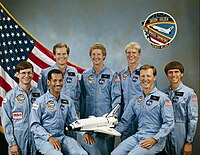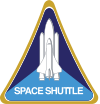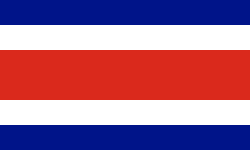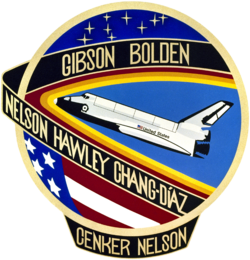STS-61-C
| Missionsemblem | |||||
|---|---|---|---|---|---|
 | |||||
| Missionsstatistik | |||||
| Missionsnavn: | STS-61-C | ||||
| Rumagentur: | NASA | ||||
| Rumfærge: | Columbia (7) | ||||
| Antal besætningsmedlemmer: | 7 | ||||
| Affyringsrampe: | LC-39A (KSC) | ||||
| Opsendelse: | 12. januar 1986 | ||||
| Landing: | 18. januar 1986 | ||||
| Landet på: | Edwards Air Force Base | ||||
| Varighed: | 6 dage 2 timer 3 min | ||||
| Foto af besætningen | |||||
 Bagved V–H: Bill Nelson, Hawley, George Nelson, Foran V–H: Cenker, Bolden, Gibson, Chang-Diaz | |||||
| Navigation | |||||
| |||||
STS-61-C (Space Transportation System-61-C var Columbias syvende rumfærge-mission. Opsendt 12. januar 1986 og vendte tilbage den 18. januar 1986.
Hovedformålet var at sætte kommunikationssatellitten Satcom Ku-1 i kredsløb.
Besætning

 Robert Gibson (kaptajn)
Robert Gibson (kaptajn)
 Charles Bolden (pilot)
Charles Bolden (pilot) (
( )
)  Franklin Chang-Diaz (missionsspecialist)
Franklin Chang-Diaz (missionsspecialist)
 Steven Hawley (missionsspecialist)
Steven Hawley (missionsspecialist)
 George Nelson (missionsspecialist)
George Nelson (missionsspecialist)
 Robert Cenker (elektroingeniør fra RCA Corporation)
Robert Cenker (elektroingeniør fra RCA Corporation)
 Bill Nelson (medlem af Repræsentanternes Hus)
Bill Nelson (medlem af Repræsentanternes Hus)
Missionen
Hovedartikler:
Eksterne henvisninger
- STS-61-C Arkiveret 30. marts 2009 hos Wayback Machine NASA (engelsk)
| ||||||||||||||||||||
| ||||||||
Medier brugt på denne side
SVG version of PNG Space Shuttle Logo/Patch.
The SATCOM Ku-1 commuications satellite spins from the protective shield of Columbia STS-61-C
STS-61-c mission patch
- Columbia, which opened the era of the Space Transportation System with four orbital flight tests, is featured in re-entry in the emblem designed by the STS-61C crew representing the seven team members who manned the vehicle for its seventh STS mission. Gold lettering against black background honors the astronaut crewmembers on the delta pattern surrounding colorful re-entry shock waves, and the payload specialists are honored similarly below the sphere.
This scene represents the end of NASA's STS-1 mission and the beginning of STS-2 in that the orbiter Columbia is arriving at Kennedy Space Center in Florida to begin the lengthy process of preparing it for STS-2. The vehicle landed at Dryden Flight Research Center on April 14 after an historic 2 1/3 day flight in Earth orbit. It was mated to this 747 aircraft, titled NASA 905, and flown over the USA to its Florida destination. It was later removed from atop NASA 905 and moved to the orbiter processing facility for the beginning of refurbishment.
Forfatter/Opretter: Kwamikagami, Licens: CC BY-SA 4.0
symbol of Mars. 16 × 16 pixel nominal dimensions, lines 2 pixel thick, square caps. Colour 75% blue: red=0 green=0 blue=191 (#0000BF).
The crew assigned to the STS-61C mission included (seated left to right) Charles F. Bolden, Jr., pilot; and Robert L. (Hoot) Gibson, commander. On the back row, left to right, are payload specialists Robert J. Cenker, and Congressman Bill Nelson. To the right of Nelson are mission specialists Steven A. Hawley, George D. Nelson, and Franklin R. Chang-Diaz. Launched aboard the Space Shuttle Columbia on January 12, 1986 at 6:55:00 am (EST), the STS-61C mission's primary payload was the communications satellite SATCOM KU-1 (RCA Americom).










